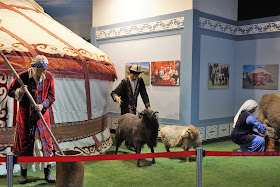Our last stop in China before we headed off to the Stans was Urumqi, the capital of the Xinjiang Autonomous Region and a major stop on the Silk Road. Another HUGE city by U.S. standards, it has a population of about 3.5 million, which makes it the largest city in Central Asia. In the Untied States, only New York City and Los Angeles have larger populations, and yet I had never heard of Urumqi before we began getting ready for this trip. Perhaps part of the reason for its lack of recognition is that it is pretty darn remote. In fact, the Guinness Book of Records says at 1,600 miles from the nearest seaport, Urumqi is the most remote major city (at least in terms of distance from the sea) in the world.
Urumqi's location is marked by red in the map of China below. The Xinjiang Region is the orange area:
 |
| Map from Wikipedia |
There was plenty of English on the signage, but not all of it was intelligible, such as this sign that invites guest to a "Whirling dance at the fingertips skills contributing to a craftsmanship."
"In the Tarim Basin and Turpan-Hami Basin, remains in the ancient cemeteries have been kept not rotten in the dry, saline environment for thousands of years. Bone, skin and hair of the corpses have been preserved well till now, which makes Xinjiang one of the regions where the largest number of corpses is kept in the world."
Sounds scary, doesn't it? This is not a museum where I would want to spent the night.
Recent DNA testing has shown that these mummies, dating from 1900 BC to 200 AD, are of mixed European and Asian descent. Some have red hair and fair skin and are quite tall for the time period, while others are more Asian in form and appearance.
She almost looks as if she is made of papier-mâché, but that is real skin, hair, and clothing:
This is an artist's rendering of what she probably looked like. Her features and coloring are much more European than Asian:
Infant mortality rates were high in those days, and the harsh conditions of this area undoubtedly added to those rates, and so of course there are baby mummies/corpses:
How about the hat on this corpse? He looks like the Straw Man in the Wizard of Oz. I'm sure the feathers are of recent vintage, but the felted wool is supposed to be original:
The strong red color of this mummy's clothing is amazing, as is the interesting position he/she is in, with the legs bent at the knees and hands crossed in front:
The bow tied around the head and the long braids seem to indicate a woman (using modern fashions), but who knows what the customs were in those days. Check out the long, slender fingers and intact fingernails:
The most interesting/creepy thing about this mummy is the extensive tattooing on the face:
Straight out of a horror film, right?
Again, the hands look almost alive, and the left hand is gripping something--a tool?
Similar to the last mummy, this one also has tattoos on the face:
Pretty good head of hair for being at least a few thousand years old:
This display shows the tattoos on each of the mummies' faces:
Some "corpses" are a little more "dried up" than others:
The mummies are the highlight of the museum, but there are a lot of other wonderful displays, including dioramas from various time periods and areas of western China. They are full of well-executed wax figures and elaborate settings:
There is that pointy hat that looks like the one worn by the Scarecrow of Oz:
One of our regrets on this trip is that we didn't get to stay in a yurt:
Several of the dioramas highlighted yurt life:
Other scenes depicted local fairs and sporting events:
This one shows a local wedding, during which the bride's face is covered with a "handkerchief" until the groom unveils her:
I love this clothing--the Swiss Alps meet the Moroccan deserts:
This description of the dangling beads that have "unique amorous feelings" is a Chinglish classic:
The people of the Xinjiang Province are exceptionally good-looking, don't you think?
Are the man with the camera and woman with the sunglasses made of wax, or are they real?
More hilarious Chinglish:
Moving on to the art. The "guard beast" on the left dates to the Tang Dynasty (618-907 AD):
Crazy creatures. The one on the left reminds me of Thailand:
This carving of a camel from the Tang Dynasty was dug up in Turpan:
The "restoration room" was visible through a large glass window:
It was time to go, so I made a quick stop at the restroom before heading out to the bus. While Bob was waiting for me, he was approached by some giggling children who wanted to get their pictures taken with him. Their parents took some pictures, and almost immediately a line formed of others who wanted to be photographed with Bob.
When I came out, there was a big line, and I so I decided we needed to get some of our own pictures. Aren't these beautiful young women? They look like American college students. And they were so friendly! How could we say no?































































The mummies were really cool. The experience of having our pictures taken was one of the weirdest of my life. I love China.
ReplyDeleteLoved the Chinglish--so much rich language to mine. Glad to see the world has finally caught up with you traveling celebrities.
ReplyDelete